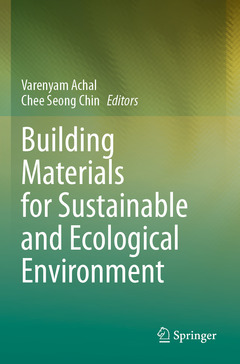Building Materials for Sustainable and Ecological Environment, 1st ed. 2021
Coordonnateurs : Achal Varenyam, Chin Chee Seong

This book uses theories, hypotheses, policies, practical insights and case studies to introduce and elucidate green building materials for sustainable construction. Cement is the most widely used building material in construction; however, it is not sustainable, being responsible for 7% of global carbon dioxide emissions and consuming huge quantities of energy. In order to limit the ecological damage, sustainable building materials are needed. Ecosystems are a source of important lessons and models for transitioning the built environment onto a sustainable path that opens options for sustainable building material in construction. The book provides a guide for readers seeking knowledge on sustainable building materials with the potential to lower environmental impact by reducing CO2 emission throughout the building?s lifecycle.
The book is motivated by recent rapid advances in sustainable building materials production, including green building materials made of industrial by-products and recycled wastes, earth materials, plant-based materials, microbial-based materials or supplementary cementitious materials, to reduce the environmental impacts of traditional building materials. Discussing the development and applications of various sustainable building materials, including related case studies, and addressing the environmental issue with a holistic and systematic approach that creates an ecology of construction for sustainability in infrastructures, it offers promising solutions to achieve renewable and sustainable building materials for the future.
Professor Varenyam Achal is Professor in environmental engineering and Deputy Dean of Undergraduate Studies at Guangdong Technion – Israel Institute of Technology (GTIIT), Shantou, China.
Prof. Achal was awarded a Ph.D. from Thapar University, India. Prior to joining GTIIT, he was Professor at East China Normal University, Shanghai. He has a very broad interest in environmental biotechnology and biological-based building materials. Some of his original research has had a global impact on microbially induced calcite precipitation and attracted worldwide attention. He has authored more than 100 research articles, book chapters, patent and technical reports. Earlier Prof. Achal has edited a book “Ecological Wisdom Inspired Restoration Engineering” published by Springer.
Professor Chee Seong Chin is Dean of Learning and Teaching of Xi'an Jiaotong-Liverpool University, supporting the University in the operational delivery of its academic strategy and the ongoing coordination of learning and teaching. Professor Chin sits on the Senior Management Team Committee, Academic Strategy Group and Academic Board as well as chairs multiple University-level committees/boards/panels that are responsible for overseeing the general policies and practices related to learning and teaching.
Professor Chin received his First-Class B.Eng. (Hons) and Ph.D. degrees in Civil Engineering from Swansea University, UK, and has more than 15 years of experience working in international higher education institutions. He is the Founding Director of the Institute for Sustainable Materials and Environment and Founding Head of the Centre for Advanced Fibre Reinforced Concrete Technology. He was previously Head of the Department of Civil Engineering.
His primary research interests are fibre-reinforced cementitious composites as well as sustainable construction an
Discusses sustainable building materials from multiple disciplinary research involving environmental science, ecology, geotechnical engineering, civil engineering, and even microbiology to provide direction for sustainable construction
Maximizes readers’ insights into how sustainable building materials can play role in reducing carbon footprint throughout the lifespan of buildings
Examines a number of topics relating to sustainable building materials to improve readers’ practical understanding
Date de parution : 05-2022
Ouvrage de 172 p.
15.5x23.5 cm
Disponible chez l'éditeur (délai d'approvisionnement : 15 jours).
Prix indicatif 137,14 €
Ajouter au panierDate de parution : 05-2021
Ouvrage de 172 p.
15.5x23.5 cm



